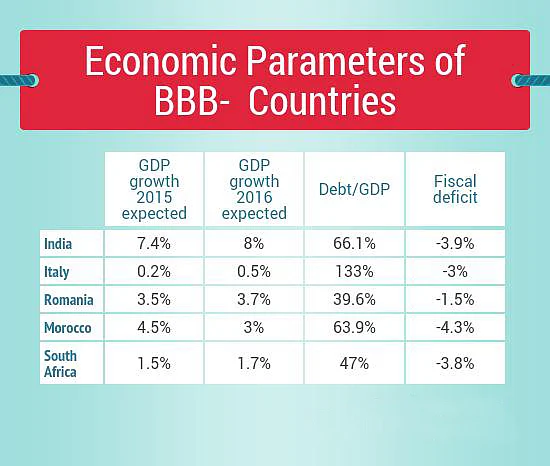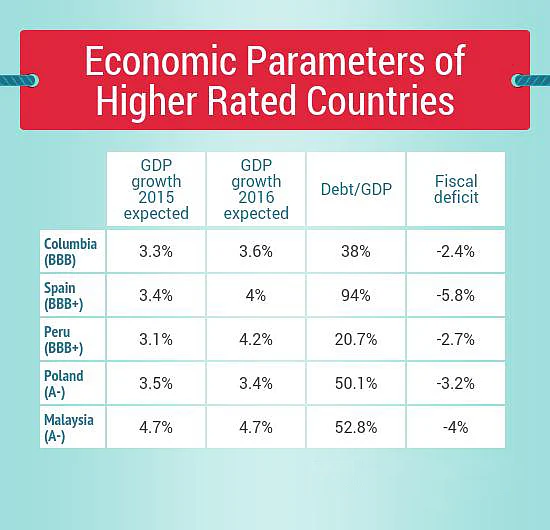The Indian government was hopeful that the slew of policy measures it has announced over the last one year and the overall strength in the economy would be reason enough for rating agencies to improve India’s ranking. However, rating agency Standard and Poor’s (S&P) not only left this year’s rating unchanged but also said that the next year’s rating will remain the same.
- India’s current S&P rating is the same as during the worst period of the global financial crisis
- India is a notch above junk grade and has the lowest possible rating in investment grade
- However, India is the best performing country among those which have the same rating
- India’s economic performance is also better than other countries which have a higher rating
Irrational Rationale
Over the years, questions have been raised on the rationale used by these agencies for rating a country. These questions became more vocal after the role of rating agencies in giving the highest possible rating to toxic assets in the sub-prime crisis was exposed.
S&P has maintained the same rating for India even during the worst period for the economy in the past decade which is BBB-, a notch above junk grade and the lowest possible rating in investment grade. A year back it had merely tweaked the rating from negative to stable without changing the overall grade from BBB-. Now that there are signs of growth revival and the overall economy has shown improvement, with various economists including those from S&P revising its numbers upwards, many in the government, economists and observers are baffled by the unchanged rating.
Though the growth rate is not the only criteria that a rating agency looks at, India is on a much stronger wicket on other parameters too. The twin deficits and inflation are under control, interest rates are falling, freebies and subsidies are being withdrawn and given on output-based criteria and, most importantly, the tax base is being increased.
India weathered the financial tsunami triggered by the sub-prime crisis much better than most developed countries which are awarded near-top grades by these rating agencies. India has never defaulted on its debt payment, even during the worst of the crisis. The country chose to sell its gold reserves rather than default on its loan. Further, on almost all parameters, India has performed better than some countries which have been rated higher.
We look at four countries which have the same rating as India and five which have a higher rating and compare them based on broader economic parameters. But before that, here is a brief background on how a country’s rating can impact its economy.

Why Rating Is Important
There is no denying the fact that the ratings these agencies accord have the power to move money between countries. By giving a rating to each country the three big rating agencies - Fitch, Moody’s and S&P - assess the capability of a country to repay its debt. Asset managers and investors deploy their money based on these ratings. Many large funds do not invest in anything lower than ‘A’ rated countries.
A lower rating would mean that a country would find it difficult to raise money and hence would have to raise its interest rates to attract capital. The government, since it came to power, has been trying to impress upon the rating agencies to improve India’s rating. A better rating would mean that the country could raise more funds at cheaper rates which is necessary for the economy to build its infrastructure and power and ports, among other things.
Now let’s look at the four countries India is clubbed with.
The Barely Investable Grade Club

India is in the same league as Italy, Romania, Morocco and South Africa with a lowest possible rating for an investable grade country, a BBB- rating with a stable outlook.
A look at some economic parameters of these countries shows that India has the fastest growth rate for the present year and the next. It’s in the middle of the bunch in terms of debt-to-GDP ratio and fiscal deficit position.
In media interactions, an S&P representative pointed to the higher level of debt and the country’s fiscal deficit for not changing the rating. India’s debt as a percentage of GDP stood at 72.5 per cent in 2010 which had come down from a peak of 84.30 per cent in 2004. It is now near its lowest level in the last two decades.
Similarly, its fiscal deficit which touched a peak of 7.8 per cent in 2010 could have touched the 3 per cent mark in 2016 but the government chose to focus on growth rather than fiscal consolidation for a few years. It is now expected to touch the 3.9 per cent mark. On a comparative basis, India is the best performing country among those which have the same rating. In fact, the outlook for India is far better than all countries in this list.
Case for a Double Promotion

India’s performance also stands out when compared with other countries which have a higher rating. Spain, which was on the verge of an economic collapse just a few years ago, fails miserably on all parameters compared to India but enjoys a higher ranking from S&P. Similarly, countries which are dependent on a single commodity, namely oil, have been given a higher ranking despite the fact that lower oil prices have destroyed their fiscal math. Regular downward revisions of the growth number and increased uncertainty has meant that S&P has steered clear of changing the ratings of countries like Columbia or Malaysia.
Biased Ratings?
Credit rating agencies are fighting court battles with various European countries and even the US for what is being called as ‘biased credit rating opinions’. Italy, which shares the same rating as India, had sued the rating agency for 234 billion euros in damages that the rating downgrade caused to the economy.
S&P officials in an interview, while being grilled on their rationale for not changing the rating, pointed out that irrespective of overall GDP growth, there is a constraint on future upgrades till the time the per capita growth remains low. India’s per capita income is around $1,700 and the next upgrade benchmark is at $5,000.
A look at Spain and Italy’s numbers clearly highlights the flaws in S&P’s logic. No doubt, these countries have higher per capital income, but the entire income is from borrowed money.
The opaque manner in which ratings are assigned and hypothetical benchmarks are set for any future change in ratings, makes one think that it’s high time somebody started rating the rating agencies.
(The writer is a Mumbai-based market analyst.)
(At The Quint, we are answerable only to our audience. Play an active role in shaping our journalism by becoming a member. Because the truth is worth it.)
